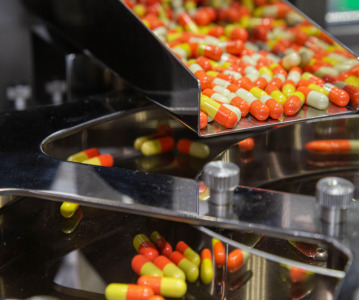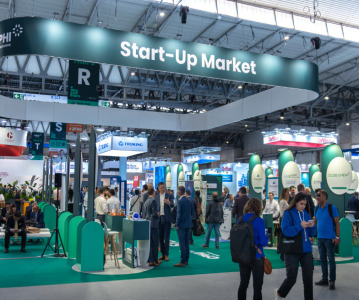I Holland woos exhibition visitors with new tabletting technologies

Company's Wear Indicator Layer attracts the most attention.
The team from I Holland has reported a very successful Achema expo in Germany this year. With thousands of visitors from around the world, the stand was overwhelmed by the positive feedback from visitors, all impressed by the company’s new tablet tooling technologies.
The product which attracted a lot of attention, and was launched during the show, was I Holland’s Wear Indicator Layer. This is an innovative coating which when applied to tooling enables tablet manufacturers to monitor tool wear helping to minimise production downtime.
Once the functional coating approaches the end of its working life cycle, a distinctive gold coloured layer is revealed allowing technicians to change tooling before production problems like sticking can take place. Sticking occurs when particles of the tablet formulation adhere to the punch face. This can become so serious that production can be interrupted, reducing yields and increasing production costs. I Holland’s Wear Indicator Layer provides a warning that tooling requires replacement before any long-term damage or delay in production can take place.
Rob Blanchard said: “Achema was a great opportunity to launch the new Wear Indicator Layer to an influential audience within the pharmaceutical industry. It received much interest from those looking to improve their tablet production methods.
“The I Holland stand was busy throughout the event, with one of the main attention-grabbing features being the live design studio. The team of design experts demonstrated how they develop tablets and tablet tooling to incorporate important features which prevent production problems like picking and sticking.
“3D CAD models and drawings of a tablet design were brought to life by transforming them into 3D printed prototypes. Visitors saw the design on the screen and then within hours were holding the finished tablet in their hand. This was a great method of showcasing the skills of our designers and giving visitors the opportunity to see how their tablets would look once produced.”
Related News
-
News Pharmapack Awards 2024 Patient-Centric Design Award Winner – Dr Ferrer BioPharma
The 2024 Pharmapack Awards celebrated the best in innovation and design for the pharmaceutical packaging and drug delivery industry on January 24, 2024. -
News Women in Pharma: Minding the Gap at Pharmapack 2024
2024 marks the first year Pharmapack will host a Diversity track dedicated to bridging the gap within the pharmaceutical packaging and drug delivery sector. The track includes a panel discussion on 'Enabling Diversity in the Workplace,' focused... -
News Pharmapack Awards 2024 - Celebrating Packaging and Drug Delivery Innovation
The 2024 Pharmapack Innovation Awards ceremony celebrated the best in pharmaceutical packaging and drug delivery innovation at all levels. The awards were held on January 24, 2024 at the Paris Expo Porte de Versailles. -
News Pharmapack 2024 - From the Floor
Paris once again welcomes Europe’s leading trade show in pharmaceutical packaging and drug delivery innovation. Join our content team as Pharmapack 2024 opens its doors to leading experts and innovators in pharmaceutical packaging and drug delive... -
News CPHI Barcelona 2023: Partnering for Success – Managing Outsourcing Relationships to Optimise Manufacturing Operations
During CPHI Barcelona 2023, insightful content sessions offered attendees the chance to explore trending topics with expert speakers and panellists. Here, we summarise what the pharma industry and supply chain are talking about the most. -
News CPHI Barcelona 2023: Loading Potential – Artificial Intelligence for Pharma Manufacturing
During CPHI Barcelona 2023, insightful content sessions offered attendees the chance to explore trending topics with expert speakers and panellists. Here, we summarise what the pharma industry and supply chain are talking about the most. -
News Pharmaceutical industry supports COP28 health stance in joint statement
As COP28 takes place over this week in Dubai, UAE, several bodies in the pharmaceutical and health industries have come together to announce support of key movements in sustainability in the sector, and to recognise sustainability as a health issue.&nb... -
News CPHI Podcast Series: Start-ups take centre stage at CPHI Barcelona
The first episode of the CPHI Podcast Series since we attended CPHI Barcelona in October covers the Start-up market at the event, with expert Matthew Wise joining Editor Lucy Chard to discuss the event.
Position your company at the heart of the global Pharma industry with a CPHI Online membership
-
Your products and solutions visible to thousands of visitors within the largest Pharma marketplace
-
Generate high-quality, engaged leads for your business, all year round
-
Promote your business as the industry’s thought-leader by hosting your reports, brochures and videos within your profile
-
Your company’s profile boosted at all participating CPHI events
-
An easy-to-use platform with a detailed dashboard showing your leads and performance





.png)

